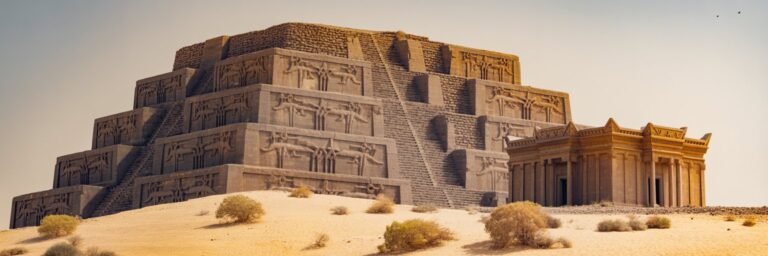INTRODUCTION
In the grand theatre of human history, ancient civilizations mark the debut act. Their rich tapestries of innovation, creativity, and resilience provide an invaluable blueprint that has shaped the course of subsequent epochs. From the wind-ruffled fields of Mesopotamia to the expansive lands of the Nile navigated by Cleopatra; from the majesty of Greece’s Parthenon to the marvels of the Indus Valley’s complex infrastructures, each civilization carved out a distinct path that illuminated the way for generations to follow. In absorbing details drawn from the annals of history, this exploration aims to cut through the time-worn veil hiding the profound impact these ancient civilizations bear on the world we know today.
HISTORICAL BACKGROUND
Ancient civilizations encompass two significant periods: the Bronze Age (3000-1200BC) and the Iron Age (1200-500BC). During these eras, convoluted communication networks and trade routes were etched into history forever. Mesopotamia, regarded as one of the earliest civilizations, sprang into existence around 3100BC. Grounded within today’s Iraq, this society characterized the initial catalyst sparking the birth of agriculture, writing, and advanced sciences.
Sailing on the timeline, the stoic Egyptian civilization commenced around 3150BC. It was here that grand, pyramidal tributes to power and death first sprung from the earth. Meanwhile, sandwiched between the gushing Ganga and Indus rivers, the Indus Valley Civilization erupted circa 2500BC, bringing a staunch, pragmatic approach to city planning and sanitation systems. Further east around 1700BC, the revered Dawn Redwood trees cast extravagant shadows upon the foundations of the Chinese Shang Dynasty.
THEORIES AND INTERPRETATIONS
Numerous theories and interpretations surround these civilizations. While mainstream history mostly agrees on the progression and key accomplishments of each, pockets of academic society propose alternative viewpoints, shuffling the linearity of history.
The generally accepted interpretation ascribes the demise of Mesopotamia to the Medes’ invasion. However, an unconventional perspective suggests environmental degradation played a more substantial role in its downfall. Similarly, the fall of the Indus Valley Civilization is commonly ascribed to Aryan invasions, although geological evidence hints at seismic activities causing river diversions and climatic change, leading to this society’s gradual downfall.
In Egypt, the Pyramids’ construction is primarily attributed to the extensive use of labor forces under the Pharaohs. Yet, tantalizing theories propose highly sophisticated tools and perhaps extraterrestrial interference.
MYSTERIES AND CONTROVERSIES
Among the labyrinth of historical evidence, there lie corridors of mysteries and controversies. For instance, the Phaistos Disk discovered on Crete in 1908 dates back to the Minoan civilization and remains undeciphered. Similarity, the purpose of Stonehenge, created by the Neolithic and Bronze Age civilizations, triggers debates. Some argue it’s an astronomical calendar, others perceive it as a sacred burial ground, and some imagine it a celestial observatory.
An intriguing conflict surrounds Egypt’s Sphinx. With the human-headed lion’s body harking back to 2500BC during the reign of Pharaoh Khafre, a minor faction ascribes its origins to a previous geological era, citing extensive erosion on its body.
SYMBOLISM AND CULTURAL SIGNIFICANCE
The symbolism found in these ancient civilizations is steeped in cultural significance, the echoes of which linger in our lives today. Mesopotamia birthed the cuneiform script, which established writing and record-keeping. Moreover, Hammurabi’s code etched in stone marked a turning point in legal justice.
The Egyptians worshipped an array of deities, manifesting in an obsession with death and the afterlife. Their complex hieroglyph script still piques curiosity, as does their robust funerary culture, which influences modern theological discussions about mortality. Chinese ancient civilizations introduced the Taoist and Confucian philosophy, which shapes social norms and personal ethics in contemporary society.
MODERN INVESTIGATIONS
Current technological advances revitalized historical investigations. Ground-penetrating radars, satellite imaging, and refined carbon-dating techniques probe the depths of these ancient civilizations, yielding previously undiscovered insights. In recent years, these sophisticated tools unveiled undiscovered facets of the Indus Valley Civilization, unearthing more cities and pushing back the civilization’s onset.
In Egypt, the ‘ScanPyramid’ project utilizes muon radiography to penetrate deep into the pyramids, unveiling hidden chambers and corridors. Meanwhile, DNA analysis of ancient Chinese human remains provides an incontrovertible history of migration, genetic cross-over, and the eventual Han Chinese lineage’s formation.
LEGACY AND CONCLUSION
Reviewing human history, it is undeniably a fact that the legacy of ancient civilizations is deeply woven into our global fabric. Their achievements in administration, architecture, astronomy, writing, and philosophy offer cornerstones upon which modern society is built. Even arduously peculiar theories, half-hidden mysteries, and the shared symbolism contribute to our collective understanding as they add intrigue and depth to history, making the story of humanity a multifaceted spectacle.
While the cosmetics of society have undeniably changed, our ancient predecessors’ influence remains palpable. It manifests in our legal systems, religious beliefs, language structure, intellectual curiosity, and even in our propensity for conflict and resolution. By continuing to unshroud these precious civilizations’ secrets, we not only gain a profound comprehension of their milestones but also understand vital strands of our own identity.






